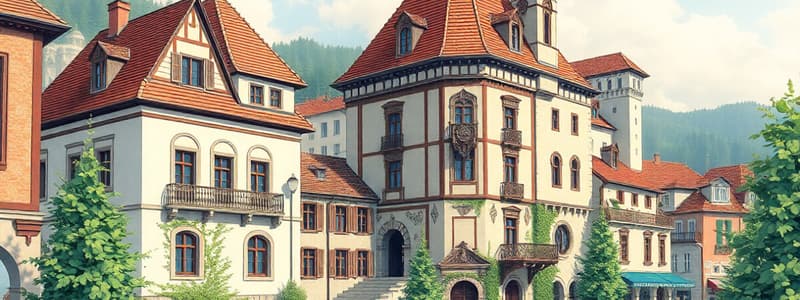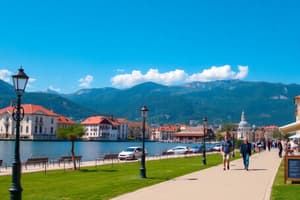Podcast
Questions and Answers
Which of the following best describes a primary difference between Montenegro's and Bosnia and Herzegovina's economic focus?
Which of the following best describes a primary difference between Montenegro's and Bosnia and Herzegovina's economic focus?
- Montenegro heavily relies on agriculture, while Bosnia and Herzegovina focuses on tourism.
- Montenegro's economy is driven by tourism, whereas Bosnia and Herzegovina depends more on agriculture and energy. (correct)
- Both countries primarily depend on industry, but Montenegro specializes in automotive manufacturing.
- Bosnia and Herzegovina is known for sea tourism, and Montenegro focuses on cultivating grains.
Serbia's agricultural sector is characterized by which combination of activities?
Serbia's agricultural sector is characterized by which combination of activities?
- Political tourism, hydroelectricity production, and export product manufacturing.
- Grain cultivation, soft drink production, and automotive manufacturing.
- Extensive vineyard cultivation, tobacco farming, and thermoelectric energy production.
- Grain cultivation, fruit and vegetable processing, and pig breeding. (correct)
A significant portion of FYROM's tourism is centered around which geographical feature?
A significant portion of FYROM's tourism is centered around which geographical feature?
- The Adriatic Sea coastline.
- The mountainous regions in the north.
- The historical war sites in Srebrnica and Mostar.
- The coasts of Lake Ohrid and Prespa. (correct)
Which of the following economic activities is specific to the South Serbia region?
Which of the following economic activities is specific to the South Serbia region?
Which factor significantly contributes to tourism in Bosnia and Herzegovina, particularly drawing people interested in recent history?
Which factor significantly contributes to tourism in Bosnia and Herzegovina, particularly drawing people interested in recent history?
Slovenia and Croatia's economies are significantly boosted by which sector?
Slovenia and Croatia's economies are significantly boosted by which sector?
Which geographical feature is most characteristic of tourism in Slovenia and Croatia?
Which geographical feature is most characteristic of tourism in Slovenia and Croatia?
What infrastructural advantage do Slovenia and Croatia possess due to their geographic location?
What infrastructural advantage do Slovenia and Croatia possess due to their geographic location?
Slovenia's landscape is largely characterized by:
Slovenia's landscape is largely characterized by:
Besides tourism, what industry significantly contributes to Slovenia's economy?
Besides tourism, what industry significantly contributes to Slovenia's economy?
What is a key characteristic of Croatia's industrial sector?
What is a key characteristic of Croatia's industrial sector?
Croatia's industrial activities, besides energy, also involve which of the following sectors?
Croatia's industrial activities, besides energy, also involve which of the following sectors?
Which of these tourist activities is particularly associated with Slovenia, but not explicitly mentioned for Croatia?
Which of these tourist activities is particularly associated with Slovenia, but not explicitly mentioned for Croatia?
Flashcards
Montenegro's Tourism
Montenegro's Tourism
Sea and mountain tourism are key, with Ulcinj, Budva, and Tivat being popular destinations.
Bosnia-Herzegovina's Economy
Bosnia-Herzegovina's Economy
Agriculture, energy (hydroelectric and thermoelectric), and political tourism related to the war's effects drive economic activity. Srebrnica and Mostar attract tourists.
Serbia's Economy
Serbia's Economy
Agriculture (grain, produce, livestock) and industry (automotive, beverages) support the economy. Southern Serbia produces hydroelectricity.
FYROM's Economy
FYROM's Economy
Signup and view all the flashcards
Serbian Automotive Industry
Serbian Automotive Industry
Signup and view all the flashcards
Service Sector & Tourism
Service Sector & Tourism
Signup and view all the flashcards
Coastal Tourism
Coastal Tourism
Signup and view all the flashcards
Mountain Tourism
Mountain Tourism
Signup and view all the flashcards
Thermal Baths (Slovenia)
Thermal Baths (Slovenia)
Signup and view all the flashcards
Developed Infrastructure
Developed Infrastructure
Signup and view all the flashcards
Forest Areas
Forest Areas
Signup and view all the flashcards
Electrical Appliances (Slovenia)
Electrical Appliances (Slovenia)
Signup and view all the flashcards
Energy Processing (Croatia)
Energy Processing (Croatia)
Signup and view all the flashcards
Study Notes
- Key sectors in the economies of Slovenia and Croatia include services and tourism.
- Tourism subcategories; coastal, green, and mountainous tourism are particularly developed.
- The countries feature developed rail and road infrastructures.
- Slovenia and Croatia are located where the arterial roads connecting Western Europe with the Balkan Peninsula intersect.
- Slovenia and Croatia have large forest expanses, covering about 3/5 and 2/5 of their total area, respectively.
- Slovenia is known for producing automotive parts, pharmaceuticals, furniture, and household appliances.
- Slovenia imports transportation equipment, petroleum, natural gas, and metals.
- Croatia is known for mining and processing petroleum and natural gas. It also has textile and food industries, as well as construction materials production.
- To meet its energy needs, Croatia imports petroleum, natural gas, and electricity.
- The agricultural sector is characterized by the cultivation of grains, potatoes, sugar beets, soybeans, sunflowers, and tobacco, as well as the raising of pigs, cattle, and poultry.
Studying That Suits You
Use AI to generate personalized quizzes and flashcards to suit your learning preferences.



